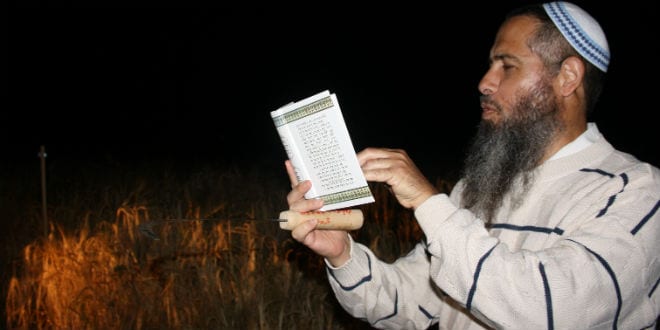When the first holiday marking the beginning of Passover ended a week and a half ago on Saturday night, a group of Jews went out to a field near Sderot in the south of Israel and harvested a small quantity of barley for a purely Biblical purpose rarely fulfilled these days: to offer up the omer, or the wave offering, to God.
Though this offering of grain technically requires the Temple and its altar, some rabbis choose to harvest the omer today because of an esoteric teaching that connects this particular mitzvah, or Biblical commandment, to the Third Temple descending, completely formed, from heaven.

For the third consecutive year, the nascent Sanhedrin and Rabbi Yaakov Savir have held this ceremony, adhering to all of its details as set out in the Books of Exodus 29:24 and Leviticus 7:20-34. Rabbi Hillel Weiss, the secretary of the nascent Sanhedrin, explained to Breaking Israel News that the omer serves a major practical purpose even today.
“Until the omer is offered on the altar, the Nation of Israel cannot partake of the grain that was harvested this year,” the rabbi said.

Rabbi Yaakov Savir led the omer ceremony. He explained how the minutiae of this mitzvah led to the rabbinic conclusion that the Temple may miraculously come down from heaven. If the Temple were standing, grain harvested from earlier this year, before Passover, would be forbidden until the wave offering is performed on the altar.
Rabbi Savir told Breaking Israel News. “Lacking the Temple, the grain is permitted at dawn since the priests performed the wave offering as early as possible in the morning and it can be assumed that they would continue to do so if it were possible.”

He explained that in the Talmud (Oral Law), Rabbi Yochanan ben Zakai, who lived in the era of the destruction of the Temple, made a special ruling that forbade eating from the newly harvested wheat until nightfall. Ben Zakai reasoned that the Temple might still be built late during the second day of Passover.
Even if the Temple was not standing at night, the omer should be prepared in case the Temple appeared, creating the opportunity to perform the omer ceremony. If someone ate the new grain and then later in the day the Temple appeared, thereby permitting the ceremony, that person would have sinned by eating new grain, albeit retroactively. Rabbi Yochanan ben Zakai’s special ruling prevented that possibility of inadvertently sinning, as unlikely as it might be.

“Rashi, a medieval commentator of the Talmud, asks how it is possible that the Temple could be built so quickly,” Rabbi Savir continued. “Rashi concludes that it is possible that Ben Zakai’s rule is based on the possibility that the Temple can suddenly appear, descending from heaven, completely ready for us to begin the Temple service. A desire to see the Temple and the Messiah is so essential to Judaism that it was natural to base this law on it.”
Rabbi Savir concluded, “If the Temple had suddenly appeared on the second day of Passover this year, we would have been prepared, ready to bring the omer to the altar.”

Since the barley was prepared but the Temple did not miraculously descend from heaven this year, the grain was burned on a replica of the altar erected in the Cardo in the Old City of Jerusalem, very near the Temple Mount. The ceremony was performed by kohanim, Jews of the priestly caste, wearing priestly garments.
Rabbi Savir explained the importance of re-enacting the Temple service today, before the Temple is rebuilt.

“All of the instruction in the Bible pertaining to the omer could practically fit in one short Tweet, and there are no illustrations in the Torah. Despite Jews adhering to the Torah with great diligence and fervor, so much was lost because we stopped doing it. Take, for example, the techelet, blue dye, in tzitzit (fringes). It used to be commonly found on the everyday garments of every Jewish male. Once we stopped doing it, it was lost.”

The procedure for harvesting and offering up the omer is carefully described by Maimonides, a medieval Torah authority. In the days of the Temple, the Sanhedrin appointed three agents to go to a field to select barley plants and bind them together while the grain remained rooted in the soil. Then they would return to Jerusalem to bring their Passover sacrifice and conduct their seder.
The next night, when the stars came out, the three agents would return to the field with scythes and tools for harvesting the barley. They were accompanied by crowds celebrating the mitzvah. The three representatives of the Sanhedrin would harvest precisely three se’ah – approximately seven-tenths of a bushel – and bring it to the Temple.

That same night, the harvested barley was flailed and winnowed. The edible seeds were roasted and finely ground. The flour was passed through 13 sifters. One-tenth of an ephah, about 14 cups, was set aside.
The next morning, a lug, about two cups, of olive oil and a handful of frankincense were added.

A kohen then took the omer offering to the eastern side of the Incense Altar, which was inside the Temple sanctuary. He would face the south-western corner of the main altar and wave the grain in a wave offering (korban tnufa). This offering is a prayer that God will send rain and dew in their proper times. The priest would then take one handful of the grain and burn it on the altar.
The miraculous return of the Jews to Israel as the fulfillment of God’s eternal covenant with Abraham has opened the doorway to a revival of Torah commandments that have not been seen in thousands of years.





